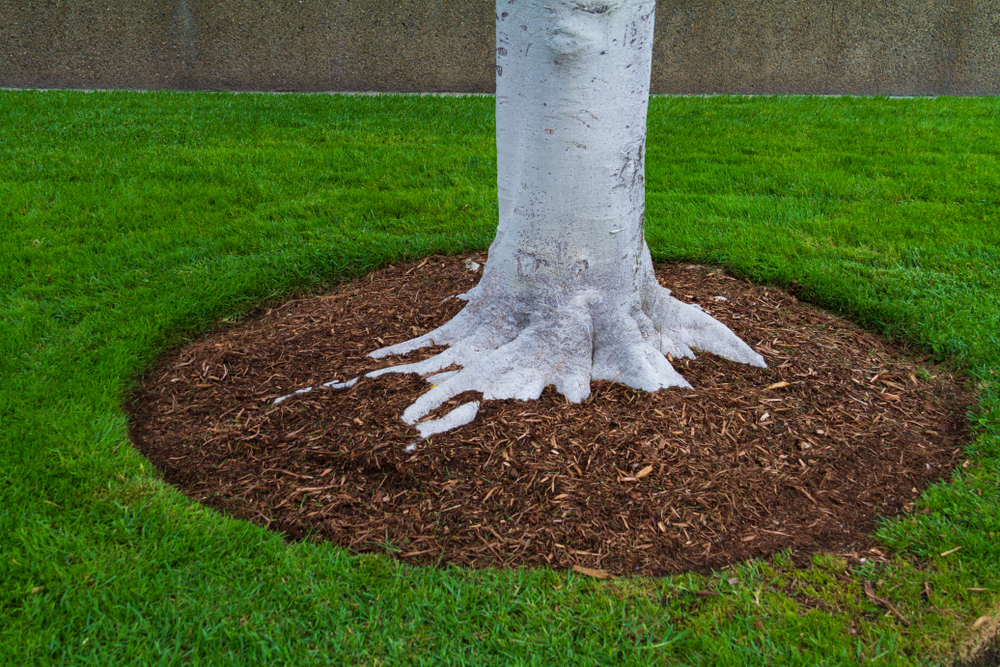
Trees may be strong and self-sufficient in many ways, but they still require care in an urban forest to grow strong and withstand the elements. The tricky part? Knowing what to do and when to do it. For example, should you fertilize in spring or summer? Is pruning better during a tree’s dormancy or right in the middle of its growing season? If you’ve ever felt unsure about how to properly care for your trees throughout the year, you’re not alone.
Thankfully, this monthly guide to tree care can help you invest in the right treatments for your trees and shrubs at any point in the year. Take a look at how you can improve the health of your property’s plants with the expertise of the arborists at Heartwood Tree Care.
January — Winter Pruning & Planting
January is a quiet time for most plants, but that doesn’t mean tree care takes a break. When trees are dormant, they enter a natural state of anesthesia. This makes winter the ideal time to reduce 25-30% of a tree’s canopy through winter pruning without causing long-term stress. Because the tree isn’t actively growing, it can focus its energy on healing and sealing pruning wounds in time for a healthy, vigorous spring season.
In addition to completing any necessary pruning, you should keep an eye out for signs of winter pests that may be hiding in bark crevices or beneath leaf litter. Certain insects, such as scale, may become problematic if left unchecked, so you should notify a certified arborist of the infestation as soon as you spot it or if you’re uncertain how to identify it.
Finally, January is the perfect time for tree planting. Cooler temperatures and dormancy give new trees a chance to establish their root systems without the added pressure of supporting foliage and photosynthesis. This head start can make a big difference in the tree’s overall health and resilience as the growing season begins.
February — Prepare for Spring Growth
As winter lingers, February is all about preparation. Make sure you finish up any dormant pruning during this month so that the tree is ready for spring. If any storm damage occurred during the colder months, take the time to address it now.
Also, tree bark should be assessed for cracks or signs of pests and diseases. If needed, this is when dormant oil sprays can help mitigate the risk of infestation of certain pests. Through scientific research, it has recently been discovered that February can also be a good time to perform bark sprays for insects such as scale, which can cause serious damage if left unchecked. Heartwood Tree Care can assist with evaluating your trees and applying the right treatments to protect their health.
This is also a great time to plan for spring fertilization and mulching to give your trees a head start when warmer weather arrives.
March — Kickstart the Growing Season
With the arrival of spring, trees begin to wake up from their winter dormancy. March is a crucial time for deep root fertilization. Applying a slow-release fertilizer now will provide essential nutrients for the upcoming growth season. Additionally, refreshing mulch around the base of trees helps retain moisture and regulate soil temperature as the weather begins to warm. Be mindful to keep mulch away from the trunk to avoid rot and pest issues.
April — Pest Control & Disease Prevention
As temperatures rise, so does the activity of pests and diseases. April is a critical time to monitor your trees for early signs of infestations or fungal infections. Consider applying preventative treatments if your trees are prone to issues such as anthracnose, scale insects, or emerald ash borers. This is also a great month to start fertilizing and deep watering if spring rainfall is low so that your trees receive the hydration they need for new growth.
May — Growth & Structural Support
By May, trees are in full growth mode, producing lush foliage and possibly flowers. If your trees and shrubs missed the opportunity to have deep root fertilizer in March or April, May is still a good time to have this service performed to provide essential nutrients that fuel healthy development through the growing season. This is also the ideal time for treating trees against pests like the emerald ash borer (EAB). These insects become active as temperatures rise, so early intervention in April helps protect vulnerable ash trees before infestations take hold.
Does your tree produce flowers? Have these flowering trees pruned after the blooms have faded to prevent complications in the future.
If your trees are in a high-traffic area, check for signs of stress caused by compacted soil, and consider aerating the ground around the roots to allow oxygen and nutrients to penetrate more effectively.
June — Summer Stress Prevention
As the heat of summer sets in, trees become more vulnerable to drought stress. In June, focus on proper watering techniques — deep watering once or twice a week is better than frequent shallow watering, as it encourages root growth. Additionally, monitor your trees for signs of heat stress, such as wilting leaves or scorched foliage, and adjust watering as needed. Now is also a good time to apply pest control measures to protect against summer insects like aphids, white flies, and borers.
July — Mid-Summer Maintenance
By mid-summer, trees are working hard to withstand heat and possible drought conditions. Continue deep watering as necessary and check for signs of pest infestations, particularly in fruit-bearing and ornamental trees.
If any weak branches are showing signs of strain, call an arborist for light pruning to remove excessive weight and reduce breakage. It’s important to hire a professional to perform this work so that there is no risk of over-pruning, which could make the tree suffer in the extreme heat.
August — Drought & Heat Management
August can bring intense heat, making it one of the most critical months for tree care. Ensuring proper hydration remains a priority, but avoid watering too late in the evening, as prolonged moisture on leaves can encourage fungal growth.
September — Early Fall Preparations
As the heat of summer fades, September marks a transition period. One important step to take during this time is to reduce the amount of water you give your trees. As growth slows and rainfall becomes more regular, too much water can lead to root rot or other issues.
It’s also helpful to note that September is when summer storms tend to pick up, bringing strong winds and heavy rain. Because your trees are still fully leafed out and under stress from peak summer heat, be sure to monitor them closely for signs of damage. Look for dead, cracked, or hanging limbs, and then call a certified arborist right away for assistance.
October — Leaf & Soil Management
October brings cooler temperatures and vibrant fall color — along with lots of falling leaves. While it might be tempting to bag them up and haul them away, those leaves can actually be beneficial for your trees. In fact, as the leaves decompose, they increase the soil’s nutrient content, which gives the tree nearly everything it needs to thrive!
Of course, you must note that you should not pile the leaves against the base of your tree. The root flare at the base of the trunk needs room to breathe, so it’s best to keep leaves or mulch at least 6 inches away to allow for proper oxygen flow and prevent rot or fungal issues.
October is also a great time for fall deep root fertilization. As trees prepare for winter dormancy, applying a slow-release fertilizer helps support root development and replenishes nutrients depleted over the growing season.
November — Late Fall Protection
As trees enter dormancy, November is a great time to add a fresh layer of organic mulch (or use the tree’s own leaves) to help insulate the roots for the winter months ahead. Be sure to leave space for the root flare to show. The mulch (or ring of leaves) should not touch the base of the tree. Instead, leave about six inches of space all around the tree’s root flare.
If you’ve been planning to plant new trees, late fall is one of the best times to do so in North Carolina. Ask the Heartwood Tree Care team for assistance establishing the perfect trees for your space.
December — Winter Inspection & Planning
December is the perfect time to reflect on your tree care efforts from the past year and plan for the upcoming one. Consider scheduling professional tree inspections during this time to catch any hidden issues before they become major problems. Additionally, if your area experiences ice and snow, be mindful of snow buildup on tree limbs, gently removing it when necessary to prevent breakage.
If your tree has become so overgrown that the canopy’s weight is compromising the structural integrity of the trunk, prioritize winter pruning in December. With trees fully dormant, canopy reduction can be done with less stress to the tree.
We Offer Essential Services for Your Tree’s Care
As you can see, there’s a lot that goes into monthly tree care. The good news is that you don’t have to do it all on your own. At Heartwood Tree Care, we provide essential tree care services that keep your trees thriving year-round. These solutions include:
- Tree health inspections to help identify potential issues early and allow for timely treatments that prevent diseases and infestations.
- Pruning to maintain strong, well-balanced trees that are free of diseased or weakened branches.
- Root invigoration and soil care to enhance nutrient uptake and improve overall tree health.
- Cabling and bracing to prevent weak limbs from breaking.
- Lightning protection to help direct and ground the lightning strike for a safer, less harmful outcome should it select the tallest tree on your property.
- Tree removal to protect your home and property from dying or compromised trees.
Let Us Help You Grow Healthy Trees for Generations to Come
Trees are one of the most valuable assets on your landscape, but simply planting a tree and hoping for the best isn’t enough — consistent care throughout the year is essential. With this guide to monthly tree care, you now have a roadmap for maintaining your trees in North Carolina’s unique climate.
Of course, if tree maintenance feels overwhelming, you can call the experts at Heartwood Tree Care. We simplify tree care by providing solutions that keep your trees thriving year after year. Contact us today to request a free estimate and find out exactly which services your trees and shrubs need this month!
